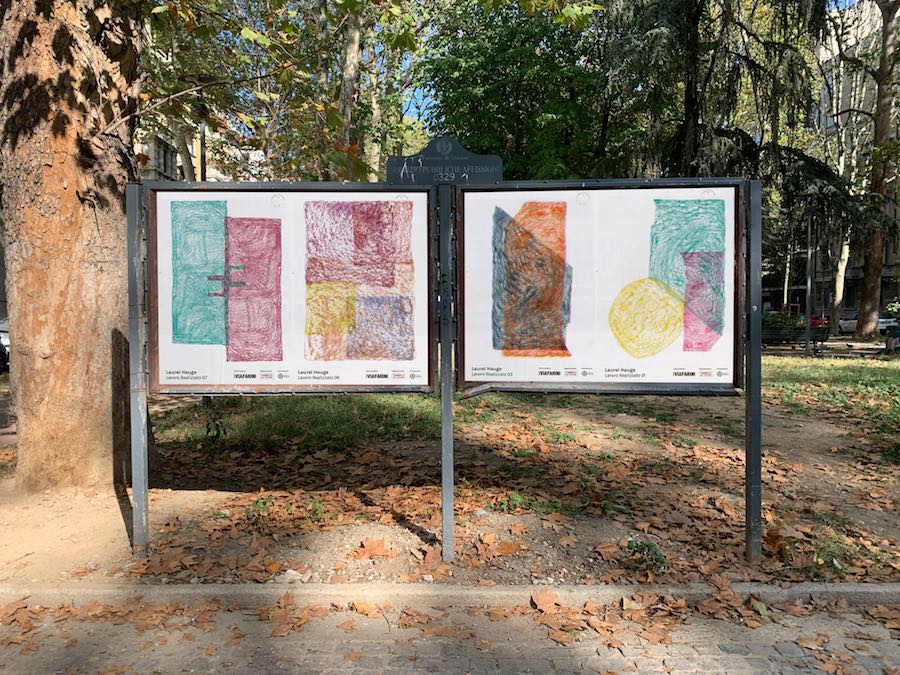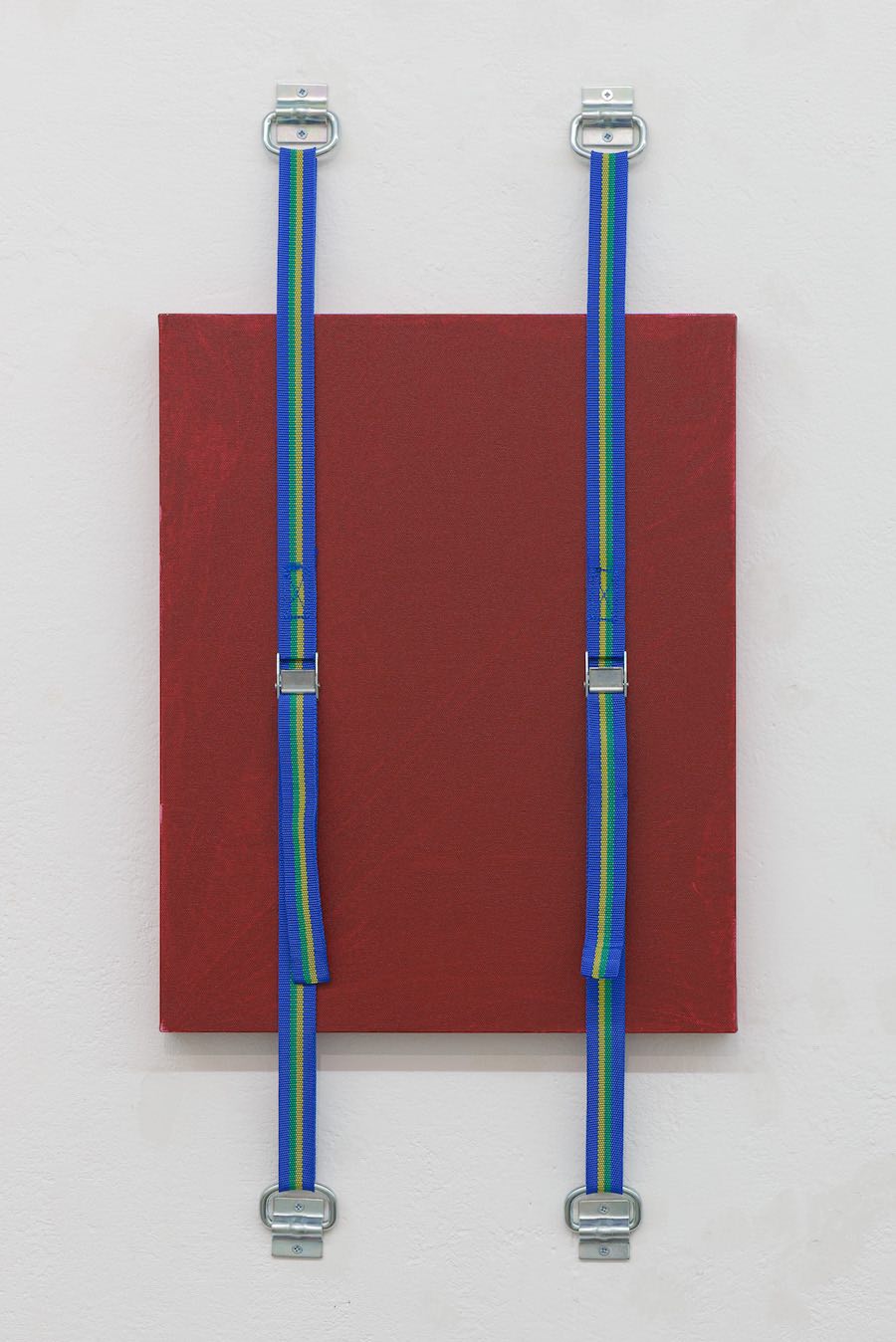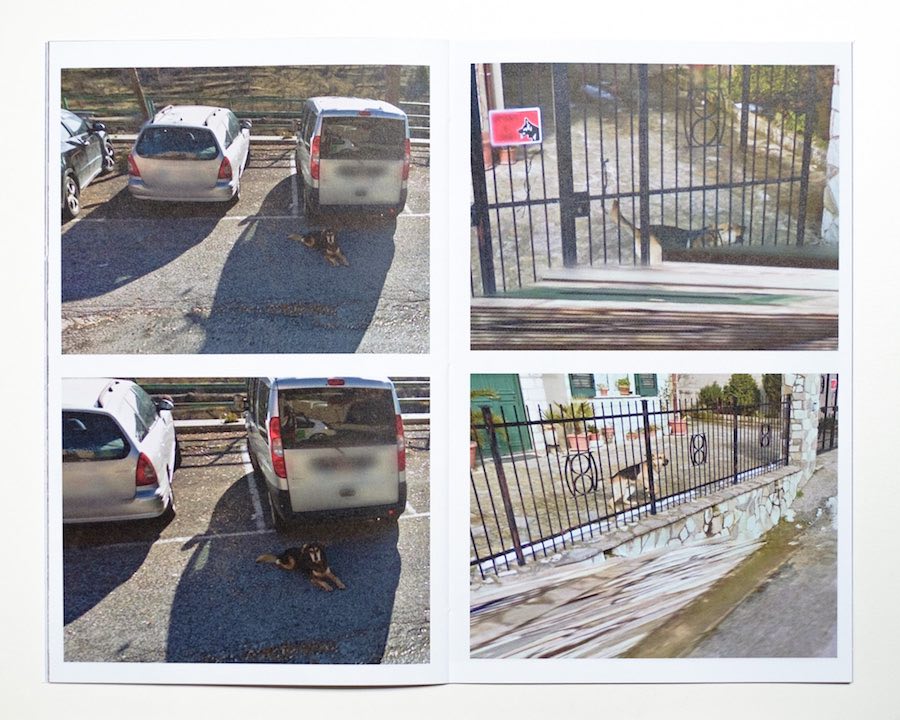
English text below —
Intervista di Marta Blanchietti e Anna Del Torchio —
Si può vedere una sorta di fil rouge nei tuoi lavori, ossia la forte componente gestuale, quasi laboratoriale. Da cosa si distingue la tua pratica dal fare manuale impiegato nella pittura o nella scultura per esempio?
Il tipo di lavoro su cui mi concentro—se fatto bene—spesso passa inosservato, a differenza delle opere dei pittori o scultori più abili. La mia pratica ha sempre operato all’interno di una struttura concettuale, indipendentemente dall’argomento o dalla tecnica impiegata. Uno dei miei progetti più recenti, Lavori Realizzati, riguarda il lavoro manuale e il processo creativo. Per realizzare queste opere, utilizzo materiale visivo creato dal lavoro al di fuori del mondo dell’arte: il mio processo per questo progetto inizia dal frottage con carboncino di forme trovate sui marciapiedi in asfalto delle città italiane, in particolare a Milano. Queste forme trovate sono il risultato di lavori di rinnovamento urbano e infrastrutturale; sono determinate sia dagli obiettivi dati ai lavoratori sia dalle loro decisioni personali nel tagliare e successivamente riempire l’asfalto. Utilizzando fotografie digitali dei miei rilievi in carboncino, ho creato composizioni visive che uniscono più forme, regolando solo disposizione, colore e dimensione. Queste composizioni vengono poi stampate su manifesti 100 × 70 centimetri e installate sui cartelloni pubblicitari di Milano dai dipendenti della città. Le opere finali di questo ciclo, o Lavori Realizzati, saranno le fotografie delle composizioni installate come affissioni pubbliche, inquadrando solo la carta applicata al cartellone.
Inoltre, c’è una forte componente di critica istituzionale e industry critique e un focus molto forte sulla dignità del lavoro artistico e uno degli aspetti interessanti del tuo lavoro è il riferimento agli art handlers, categoria di cui anche tu fai parte oltre ad essere artista. Come mai è così importante per te inserire questa componente nella tua pratica?
La maggior parte degli artisti che lavorano come addetti all’allestimento di mostre probabilmente non vedranno mai la propria arte maneggiata con la stessa cura che dimostrano ogni giorno al lavoro. Sebbene il ruolo dell’allestitore sia quello di maneggiare le opere d’arte in modo da non alterare o, nel peggiore dei casi, danneggiare gli oggetti, la mia serie di performance Fine Art Services impiega queste azioni non invasive come mezzo per creare opere, mettendo il lavoro al centro dell’attenzione del pubblico. Gli atti coinvolti in un Fine Art Service sono specificatamente quelli svolti da chi si occupa di arte: stuccare, dipingere, misurare, martellare, livellare, appendere opere… Sebbene gli art handlers siano spesso artisti essi stessi, le numerose mansioni richieste dal loro lavoro quotidiano includono la cura di opere d’arte diverse dalla propria, trattando ogni pezzo come l’ultimo Van Gogh esistente. In un campo fondato sulla soggettività, l’allestitore deve agire in modo oggettivo: tutta l’arte è qualitativamente uguale. Questi atti non solo non sono visti dal pubblico, ma sono anche intenzionalmente nascosti, nelle gallerie chiuse per l’installazione, nei laboratori dei conservatori o nelle aree preparatorie, spesso nelle viscere delle istituzioni. Uno degli obiettivi di questa serie è quello di realizzare un’arte non solo concepita in un contesto sociale, ma anche alimentata da questo.
Questo in realtà non è il tuo primo ciclo di residenza in Viafarini. Come è cambiato, se è successo, il tuo percorso a contatto con gli altri residenti?
Sono molto contenta di aver continuato la mia residenza in Viafarini dal momento che mi ha permesso di vedere come il mio lavoro si inserisca in contesti differenti – il mio primo gruppo di lavori era a un livello più internazionale, mentre quello realizzato in questa seconda parte di residenza è più legato all’Italia. Inoltre, partecipare a più cicli di residenza mi ha portata ad approfondire temi più ampi piuttosto che progetti specifici. A metà del mio primo ciclo, ho passato circa un mese a lisciare una delle pareti del mio spazio, in cui poi ho successivamente, nel corso del tempo restante, realizzato un’azione performativa tratta dalla mia serie Fine Art Services. In questo lavoro, Fine Art Service #2a, sono andata in studio in giornate specifiche e stabilite in precedenza per dipingere, ogni giorno, una sezione di parete. La grandezza della parte di muro da dipingere era decisa nel programma della performance e dalla dimensione stessa del muro; il rettangolo dipinto era posizionato verticalmente e centrato all’altezza degli occhi di una persona differente ogni giorno.
Oltre alla tua pratica artistica, hai anche una casa editrice indipendente, Have a Nice Day Press. Come funziona e di che cosa vi occupate principalmente?
Have a Nice Day Press è nata quando io e il mio partner Lele Buonerba abbiamo realizzato un nostro primo libro dal titolo Attenti al Cane: Twentysix Dogs Found on Street View, che era semplicemente una raccolta di screenshots di cani trovati su Google Street View in Italia. La nostra casa editrice ha intenzione di pubblicare libri d’artista, multipli e altre forme di lavori che nascono dal rapporto con internet e la vita digitale. La nostra pubblicazione più recente, Poems Sneaking Through a Sieve, dedicata al lavoro di Riley Cavanaugh, artista che attualmente vive e lavora a Berlino, raccoglie una serie di poesie collocate sopra i CAPTCHA delle immagini di Google e altre realizzate ritagliando parti di e-mail di spam.


Staging the Residency vol. II | Laurel Hauge
Interview by Marta Blanchietti and Anna Del Torchio —
It’s possible to see a kind of common thread throughout your works, a strong gestural, almost laboratorial component. How does your practice differ from the manual making employed by painters or sculptors for example?
The type of labor I focus on—when done well—is often unnoticed, unlike the efforts of well trained painters or sculptors. My practice has always operated within a conceptual framework, no matter the subject matter or medium. One of my most recent projects, Lavori Realizzati (Realized Works), concentrates on both manual labor and the creative process. To make these works, I source visual material created by labor outside the art world. For this iteration of the series realized in Milan, I made charcoal rubbings of forms found on Italy’s asphalt sidewalks. These forms are the result of construction work; determined by both the workers’ objectives as well as their personal decisions when they cut and remove asphalt, then subsequently refill the area. Using digital photographs of the rubbings I created visual compositions, adjusting only color and proportional scale. These compositions were then printed at 100 × 70 centimeters and will be installed onto Milan’s advertising boards by city employees in the beginning of December this year. The final realized artworks—or Lavori Realizzati—will be photographs of the publicly installed compositions, framed to show only the paper applied to the board.
Furthermore, there is a strong component of institutional and industry critique as well as a very strong focus on the dignity of artwork. Another interesting aspect of your work is the reference to art handlers, a category which you also belong to in addition to being an artist. Why is it so important for you to include this component in your practice?
Most artists working as preparators will probably never see their own art handled with the same care they demonstrate every day at work. Though the preparator’s role is to handle works of art in a way that does not alter—or worst-case damage—the objects they handle, my series of performances, Fine Art Services, employs these non-invasive actions as the means for creating works, while putting labor at the center of the audience’s attention. The acts involved in a Fine Art Service are specific to those carried out by art handlers: spackling, painting, measuring, hammering, leveling, hanging works, etc. Though preparators are often artists themselves, the numerous duties required of their day jobs include caring for artworks other than their own; treating every piece like the last van Gogh. In a field founded on subjectivity, the preparator must act objectively; all art is qualitatively the same. These acts are done not only unseen by the public but intentionally hidden, in galleries closed for installation, conservators’ workshops, or preparatory areas often in the bowels of institutions. One goal of this series is to realize art that is not only conceived in, but also informed by, a social setting.
In reality, this isn’t your first residency cycle in Viafarini. Has your experience differed with the changeover of other residents and how?
I’m very happy to have continued my residency in Viafarini as it has allowed me to see how my work fits into different contexts—both a more international one in my first cycle as well as a more Italian centric one in this current cycle. In addition to this, participating in multiple cycles has allowed me to expand on larger themes instead of specific projects. In the middle of my first cycle I spent about a month smoothing out one of the walls of my space, onto which I then realized a performative intervention from my Fine Art Services series over the course of the remaining month of the residency. In this piece, Fine Art Service #2a, I went into the studio on scheduled days to paint a section of the prepared wall each day. The dimensions of the painted portion was determined by the performance schedule as well as the wall’s dimensions, the painted rectangle was positioned vertically centered to the eye height of a different person each day.
In addition to your artistic practice, you also have an independent publishing house, Have a Nice Day Press. How does it work and what do you mainly deal with?
Have a Nice Day Press was born when my partner Lele Buonerba and I made a book of our own called Attenti al Cane: Twentysix Dogs Found on Street View, which is just that: screenshots of dogs found on Google Street View in Italy. Our press aims to publish artist books, editions and other forms of artworks which have been informed by the internet as well as digital life. Our most recent publication, Poems Sneaking Through a Sieve by Berlin based artist Riley Cavanaugh is composed of poems placed over Google image CAPTCHAs as well as poems made by removing parts of spam emails.










